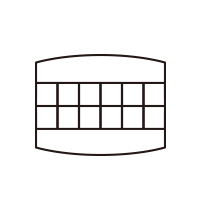Dental attrition and acid erosion treatment
「If damage caused by excessive friction between the teeth or acid damage, is left untreated, it will get worse」
You get twinges in your teeth (excessively sensitive teeth) - it hurts when you bite (occlusion pain) - your teeth are wobbly (tooth mobility) Friction between your teeth is abrading them (dental attrition) ― you grind your teeth involuntarily (dental attrition) - the inside of your mouth is exposed to acid which is dissolving the surface of your teeth (acid erosion). These are referred to as “occlusion disorders”.
This is the most common form of destructive dental disorder, and causes discomfort and pain in the teeth, muscles and jaw joint. It is a major cause of problems requiring extensive repair work. Quite likely you are not familiar with the term, but these days most dental problems and worries are tooth damage caused by these occlusion disorders.
The point is that not all of these are caused by bacteria in the oral cavity.In other words, however much you work on oral care or wait and see what happens, this is meaningless, and without fundamental treatment, occlusion disorders will continue to progress.
It used to be said that it is difficult to find indications of occlusion disorders, but the indications and symptoms can easily be identified with a proper examination, and treatment can be carried out with a high degree of confidence.
Carrying out treatment before the damage progresses greatly
reduces the complexity and cost of treatment.
You may think it strange that hypersensitivity is an occlusion disorder. Of course hypersensitivity can occur if your teeth become worn away through daily use of a stiff toothbrush or toothpaste containing whitening abrasives, but the damage from overly hard biting or from grinding your teeth is more serious than this, and in general the first noticeable symptom is hypersensitivity.

If your teeth persistently or occasionally give you twinges, we recommend having a bite examination. With symptoms like painful twinges in your teeth, even if you have been told you will have to remove the tooth nerve, we may be able through a bite examination to find a way to keep the nerve, and a way of coping with and treating the symptoms , so please ask us.
-
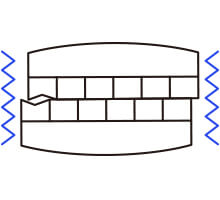
Dental attrition
e erosion that occurs as a result of unnecessarily forceful biting, grinding the teeth, clenching the teeth, tongue thrusting, or uneven biting. The white surface part of the teeth, called the enamel, is the hardest structure in the body, and if the attrition goes beyond this enamel and reaches the softer brown layer of dentin beneath (the brown areas in the photographs), attrition proceeds rapidly - seven times as fast. The teeth will become even shorter, and the brown colour of course looks less attractive.
-
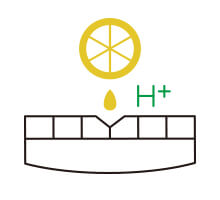
Acid erosion
Acid erosion is damage caused to the surface of the teeth when for some reason the inside of the mouth is consistently acidic. Particularly in cases where the upper front teeth have become thinner by being dissolved, the reason is often binge eating, in which the teeth are dissolved by acid from repeated powerful vomiting. The lower front teeth are protected by the tongue and are relatively less affected. Reflux oesophagitis also dissolves teeth through the hydrochloric acid and other substances in the gastric juices, which particularly dissolve the reverse side of the back teeth, which helps in diagnosis. Acidic (pH of 5.5 or less) foods and drinks all dissolve the teeth. Typically this happens through consuming set quantities of sweet fizzy drinks, lemon juice, vinegar or wine etc. on an almost daily basis.
Examples of attrition and acid erosion
-
Attrition of upper right molars
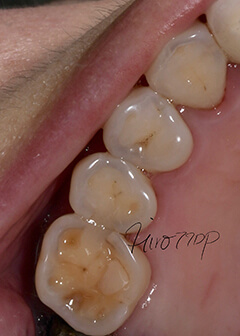
They are all worn away equally.
-
Attrition and caries in lower right molars
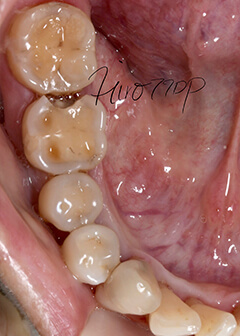
If left untreated, this will lead to the nerve having to be removed.
-
Attrition of molars and substantial build-up of tartar on the back of the lower front teeth
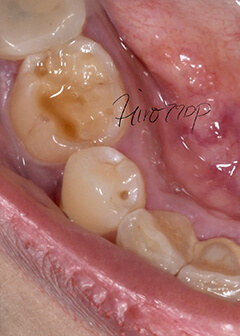
It looks as though specific teeth have been exposed to excessive force. The hollows in the teeth are typical of tooth attrition.
-
Eroded hollows in the left front teeth
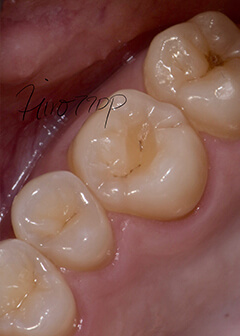
It looks as though specific teeth have been exposed to excessive force. The hollows in the teeth are typical of tooth attrition.
-
Attrition of molars and bone protuberance
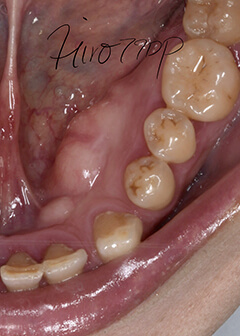
(The bumpy section of bone inside the teeth is referred to as bone protuberance, which occurs when the bone gradually grows and protrudes as a result of stimulation from an excessively powerful bite.) This shows that the force of the bite is unusually strong, and is not a particularly dangerous disorder.
-
Attrition of silver-capped tooth
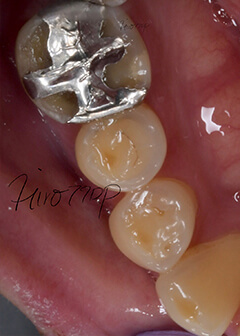
The silver-capped tooth in particular has worn away, resulting in a gap between it and its neighbour. Caries can easily occur in gaps with metal fillings.
-
Typical attrition of front teeth
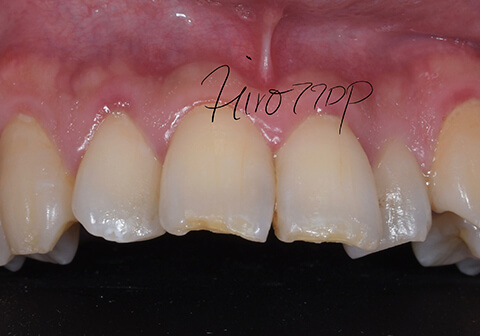
This particularly occurs through the habit of grinding teeth at night. The front teeth above (a case where the lower jaw is being pushed forward and abrading the upper front teeth) are being pushed against the lower front teeth every day, and they are likely to move further forward in future (i.e. buck teeth).
-
Attrition and cracking of front teeth
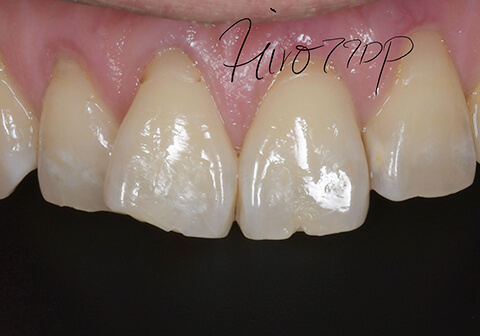
:If untreated the crack will expand. If we do not reduce the burden of the force of the bite on the front teeth, the cracking will proceed further.
-
Attrition spreading throughout/ to the lower front teeth
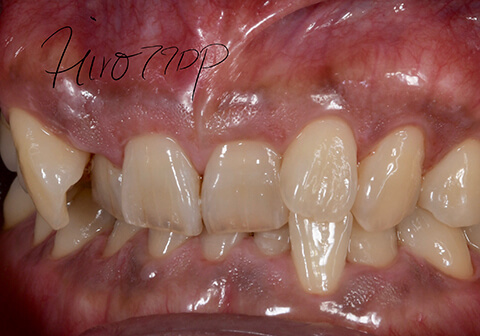
This was originally a deep bite, but after many years of attrition the upper and lower front teeth have significantly eroded and the lower front teeth have been worn away so far that they are on the point of disappearing from sight.
-
Medium attrition
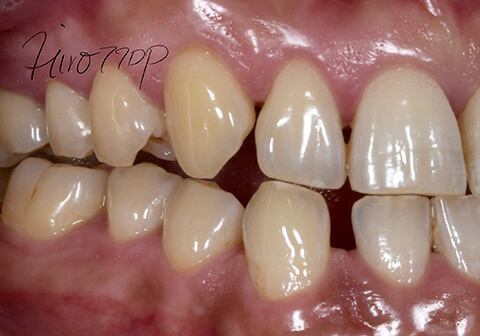
The teeth have all worn away evenly. There is no caries, but gum disease arising from the bite is making the molars wobbly, and there are deep pockets in the gums.
-
Severe attrition
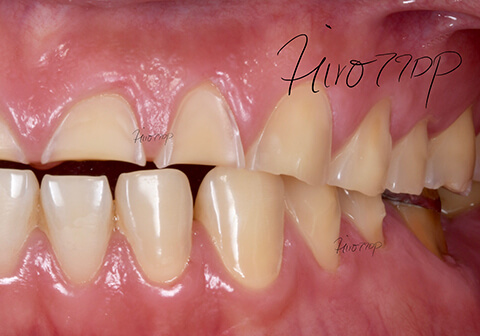
The erosion of the teeth is now causing them to lose their original shape. This needs urgent treatment.
-
An example of combined attrition and acid erosion
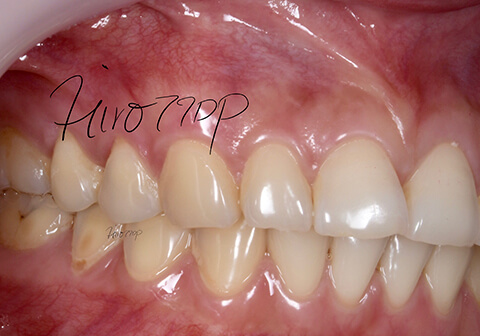
This patient had a powerful bite and teeth-grinding, and was additionally drinking lemon juice every day.
Fees
Treatment for attrition or acid erosion requires comprehensive treatment of the teeth and jaw joint.
Examination and diagnosis before treatment requires a bite examination(¥37,000) and diagnostic cast (¥110,000-150,000).
During and after treatment you will need to wear a night guard (¥12,000) when sleeping, or a relaxation/occlusal splint (¥33,000) for the jaw jointand tendons.
Other Treatments
-
- Bite balance treatment
- Jaw Joint treatments
- Preventative Dental Treatments
- Gum disease and tooth ridge treatments
- Endodontic treatment and removal of silver caps
- Dental attrition and acid erosion treatment
- Dental Aesthetic Treatments
- Dental Implants
- Orthodontic treatments
- Cleaning & Whitening
- Second opinions
- Intravenous sedation


 Open from 8.30am, including Saturdays
Open from 8.30am, including Saturdays 03-6453-0500
03-6453-0500 booking
booking access
access